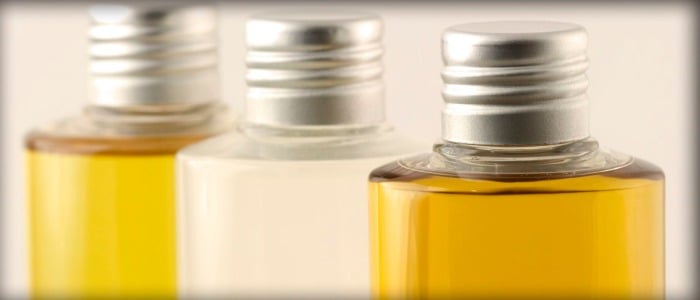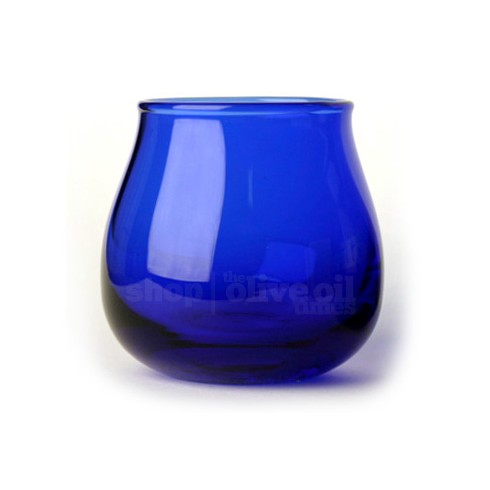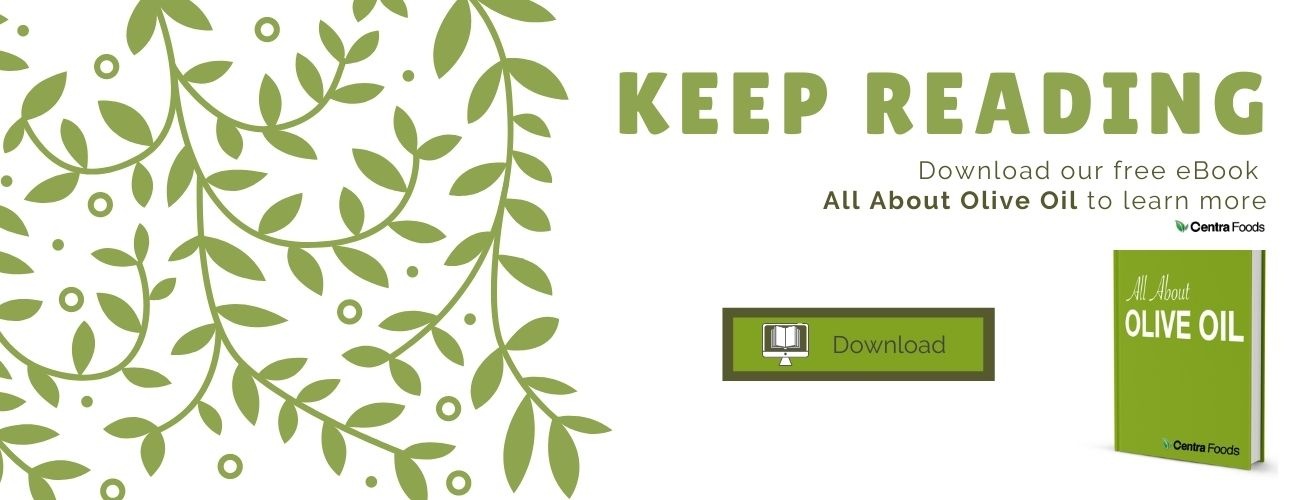
Did you know there is a certain way you should taste olive oil? Olive oil, in particular, has a specific way that it should be tasted to get the full effect and nuance of its flavors -- just like you would with wine.
We love to train both staff and customers on the proper way of tasting. Here is a quick run down of how to do it like the professionals.
First Get the Correct Glass

The tasting glass of choice by the International Olive Council is a small blue glass that is tulip shaped. If you are not looking to do it the professional way (or not wanting to order those glasses) you can also use a stemless wine glass.
The reason why they choose the blue colored glass is because the glass hides the color of the oil inside, allowing for truly blind tasting. The goal is for you to avoid any visual biases you might have. For example, if you see a very green olive oil your brain may associate the color green with good quality oil, which would affect your final judgement.
Those in the industry agree: color doesn't mean anything when it comes to olive oil. When looking at an oil like Extra Virgin, it can be light colored and still have the most pungent flavor. In comparison, a dark green extra virgin olive oil oil can still be mild flavored or of poor quality. Color and flavor are two totally unrelated traits.
Of course, if you are doing an informal tasting without blue glasses, we would simply encourage you to not judge the oil based off the color.
Olive Oil Tasting Steps
Warm up The Oil
The key to releasing the aroma and flavor of the oil is to warm it up. You will want to pour about 1-2 tablespoons of oil into your glass. Then place one hand in a cupping position under the bottom of the glass and one hand on top. The bottom hand functions to warm the oil, while the top hand contains any smell particles. The final step is to swirl it around a few times to release the smell into the air, trapped inside your cupped hand.
Smell The Oil
When it comes to how to smell the oil, think of the way you would smell wine. Bring the glass up to your nose, remove your hand and smell the oil deeply. Make sure to take note of the aromas you are smelling. Look for adjectives such as ripe, green, fruity, nutty etc. Perhaps you will be able to smell some of the exact flavors in the list below. You will want to take note of them before you taste the oil.
This is the part that really allows you to fully taste the EVOO in the next step.
Slurp/Taste The Oil
It's time to taste the oil. You will want to take a small sip of your oil. Coat the inside of your mouth and let the flavors cover your tongue by keeping your mouth relaxed. Allow it to sit for a moment.
Next, suck in some air keeping the oil in your mouth at the same time. You can do this by touching your tongue to the back of your top teeth and inhaling through the sides of your mouth, over your molar teeth. Another way is to pretend that you have straws in your mouth like walrus teeth, and that you are using them to suck in air. The sharp inhalation of air through your teeth sprays the oil around your mouth allowing all of the different tastebuds on your tongue to fully experience the flavors. The air also picks up aromas and brings them into the nasal passages for a more in-depth tasting experience.
Close your mouth with the oil still inside and breath out. Note any/all flavors you just experienced.
Swallow The Oil
The final step is you will want to swallow some of the oil to get the full flavor notes. You will find some flavors are only tasted on the back of the tongue, so this is where you will taste some of the pungency of the oil.
If you find that you are tasting a peppery oil, it's common in this stage that the oil will make you involuntarily cough. Some growers say that if it doesn't make you cough, it's not truly good oil. That is not fully true; it all just comes down to personal preference on flavor.
Note The Flavors You Taste
Finally, make notes of the flavors that you smelled and tasted throughout this process. Look for adjectives like the following:
Apple/Green Apple: indicative of certain olive varietals
Almond: nutty (fresh not oxidized)
Artichoke: green flavor
Astringent: puckering sensation in mouth created by tannins; often associated with bitter, robust oils
Banana: ripe and unripe banana fruit
Bitter: considered a positive attribute because it is indicative of fresh olive fruit
Buttery: creamy, smooth sensation on palate
Eucalyptus: aroma of specific olive varietals
Floral: perfume/aroma of flowers
Forest: fresh aroma reminiscent of forest floor, NOT dirty
Fresh: good aroma, fruity, not oxidized
Fruity: refers to the aroma of fresh olive fruit, which is perceived through the nostrils and retro-nasally when the oil is in one’s mouth.
Grass: the aroma of fresh-cut (mowed) grass
Green/Greenly: aroma/flavor of unripe olives
Green Tea: characteristic of some unripe olive varieties
Harmonious: balance among the oil’s characteristics with none overpowering the others
Hay/Straw: dried grass flavor
Herbaceous: unripe olive fruit reminiscent of fresh green herbs
Melon: indicative of certain olive varietals
Mint: indicative of certain olive varietals
Pear: indicative of certain olive varietals
Peach: indicative of certain olive varietals
Peppery: stinging sensation in the throat which can force a cough (see pungent)
Pungent: stinging sensation in the throat which can force a cough (see peppery)
Ripely: aroma/flavor of ripe olive fruit
Round/Rotund: a balanced, mouth-filling sensation of harmonious flavors
Spice: aroma/flavor of seasonings such as cinnamon, allspice (but not herbs or pepper)
Sweet: characteristic of mild oils
Tomato/Tomato Leaf: indicative of certain olive varietals
Tropical: indicative of ripe olive fruit with nuances of melon, mango, and coconut
Walnut/Walnut Shell: nutty (fresh not oxidized)
Wheatgrass: strong flavor of some green olive fruit
Woody: indicative of olive varietals with large pits
Topics: Olive Oil













